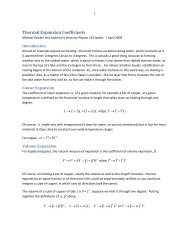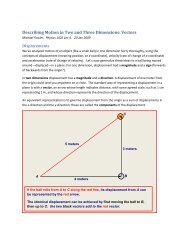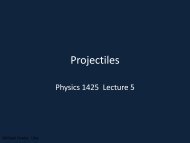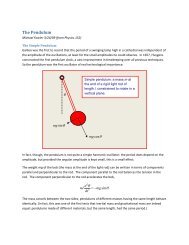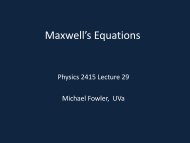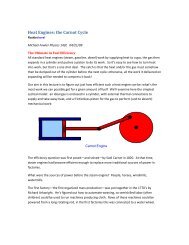PDF - Tycho Brahe and Johannes Kepler - Galileo and Einstein
PDF - Tycho Brahe and Johannes Kepler - Galileo and Einstein
PDF - Tycho Brahe and Johannes Kepler - Galileo and Einstein
Create successful ePaper yourself
Turn your PDF publications into a flip-book with our unique Google optimized e-Paper software.
previous index next<strong>PDF</strong><strong>Tycho</strong> <strong>Brahe</strong> <strong>and</strong> <strong>Johannes</strong> <strong>Kepler</strong>(Condensed Version: see below for links to fuller version)Michael Fowler University of VirginiaThese two colorful characters made crucial contributions to our underst<strong>and</strong>ing of theuniverse: <strong>Tycho</strong>’s observations were accurate enough for <strong>Kepler</strong> to discover that theplanets moved in elliptic orbits, <strong>and</strong> his other laws, which gave Newton the clues heneeded to establish universal inverse-square gravitation.What you should know:<strong>Tycho</strong> <strong>Brahe</strong> (1546-1601), from a rich Danish noble family, was fascinated byastronomy, but disappointed with the accuracy of tables of planetary motion at the time.He decided to dedicate his life <strong>and</strong> considerable resources to recording planetarypositions ten times more accurately than the best previous work. After some earlysuccesses, <strong>and</strong> in gratitude for having his life saved by <strong>Tycho</strong>’s uncle, the king ofDenmark gave <strong>Tycho</strong> tremendous resources: an isl<strong>and</strong> with many families on it, <strong>and</strong>money to build an observatory. (One estimate is that this was 10% of the gross nationalproduct at the time!) <strong>Tycho</strong> built vast instruments to set accurate sights on the stars, <strong>and</strong>used multiple clocks <strong>and</strong> timekeepers.He achieved his goal of measuring to one minute of arc. This was a tremendous featbefore the invention of the telescope. His aim was to confirm his own picture of theuniverse, which was that the earth was at rest, the sun went around the earth <strong>and</strong> theplanets all went around the sun - an intermediate picture between Ptolemy <strong>and</strong>Copernicus.<strong>Johannes</strong> <strong>Kepler</strong> (1571-1630) believed in Copernicus’ picture. Having been raised inthe Greek geometric tradition, he believed God must have had some geometric reason forplacing the six planets at the particular distances from the sun that they occupied. Hethought of their orbits as being on spheres, one inside the other. One day, he suddenlyremembered that there were just five perfect Platonic solids, <strong>and</strong> this gave a reason forthere being six planets - the orbit spheres were maybe just such that between twosuccessive ones a perfect solid would just fit. He convinced himself that, given theuncertainties of observation at the time, this picture might be the right one. However,that was before <strong>Tycho</strong>’s results were used. <strong>Kepler</strong> realized that <strong>Tycho</strong>’s work couldsettle the question one way or the other, so he went to work with <strong>Tycho</strong> in 1600. <strong>Tycho</strong>died the next year, <strong>Kepler</strong> stole the data, <strong>and</strong> worked with it for nine years.He reluctantly concluded that his geometric scheme was wrong. In its place, he found histhree laws of planetary motion:
2I The planets move in elliptical orbits with the sun at a focus.II In their orbits around the sun, the planets sweep out equal areas in equal times.III The squares of the times to complete one orbit are proportional to the cubes of theaverage distances from the sun.These are the laws that Newton was able to use to establish universal gravitation.<strong>Kepler</strong> was the first to state clearly that the way to underst<strong>and</strong> the motion of the planetswas in terms of some kind of force from the sun. However, in contrast to <strong>Galileo</strong>, <strong>Kepler</strong>thought that a continuous force was necessary to maintain motion, so he visualized theforce from the sun like a rotating spoke pushing the planet around its orbit.On the other h<strong>and</strong>, <strong>Kepler</strong> did get right that the tides were caused by the moon’s gravity.<strong>Galileo</strong> mocked him for this suggestion.A much fuller treatment of <strong>Tycho</strong> <strong>Brahe</strong> <strong>and</strong> <strong>Johannes</strong> <strong>Kepler</strong> can be found in my 1995notes:Links to: <strong>Tycho</strong> <strong>Brahe</strong> <strong>Kepler</strong>More <strong>Kepler</strong>previous index next<strong>PDF</strong>





